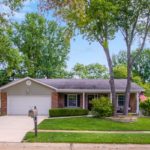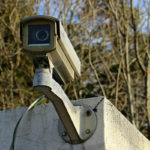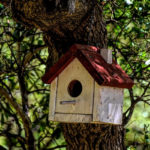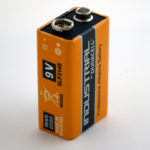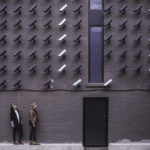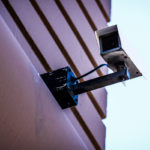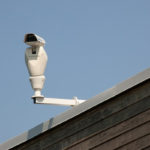Secure Your Home
When was the last time you evaluated your home security? With summer, and likely a vacation or two, around the corner, now is a great to time reassess your home security measures and upgrade or improve them as needed.
Doors
A surprising amount of burglars enter homes through the front door, so be sure that all of your doors (especially the front door) are strong and secure. Inspect the door frame, ensure the hinges are protected, and if your door has a mail slot, make sure someone can’t reach through and unlock the door.
To further safeguard your doors and entryways, you can install a deadbolt and/or add a strike plate. You can even upgrade to smart locks or install a doorbell camera. And if you have any sliding glass doors, remember to reinforce them by using a window bar or dowel in the track. Or you can invest in a door sensor or glass break sensor, which will alert you if the door is opened or tampered with.
Windows
Another common entry point for burglars is windows. And unfortunately, window latches and locks can be flimsy and rather ineffective. To better secure your windows, install improved locks or key-operated levers, or implement window bars. You can even reinforce the glass with window security film and install window or glass break sensors. In addition, you can plant prickly bushes under first-floor windows, but be sure to keep them trimmed.
Lighting & Landscape
Intruders want to be as inconspicuous as possible, so why not shine a light on them? Outdoor lighting can help to keep burglars at bay. Light up your yard (front and back) and pathways and place lights near the garage or other outdoor structures. Motion-activated lighting, solar-powered lights and timers can be helpful as well.
While the lights help to prevent burglars from hiding in the darkness, maintaining your landscape plays an important role, too. Be sure that trees and shrubs are trimmed down to eliminate any hiding spots. If there are trees near windows, remove them or add extra security to those windows. And remember to put away stools, ladders, and other tools and lock your gates and sheds.
Garage
An attached garage offers another way to access your house. But even if it is detached, burglars know there’s likely good stuff stored in there. You should always lock all doors to the garage, both interior and exterior. Consider keeping your garage door opener in the house. That way, a burglar can’t steal it from your car. You may even consider upgrading to a smart garage door opener, which alerts you when the door is opened or closed and enables you to control it remotely.
Wi-Fi Network
Securing your home wireless network is also an important part of your overall home security. To keep hackers off your home network, be sure to secure your wireless router and enable WPA (Wi-Fi protected Access) or WPA2 encryption. You should also rename and hide your network, use a firewall, install antivirus and anti-malware protection, and always create strong passwords and change them periodically.
Security System
These days, you can find a home security system that suits your needs and budget. Depending on your unique situation, you may consider DIY versus professional installation, along with the upfront and monthly costs, and the different features offered.
If they are not part of your security system, you may want to install security cameras outdoors, indoors, or both. Some features to look for include remote access, motion detection, night vision, and Wi-Fi capability. If you need assistance, you can visit SecurityCamExpert.com or call us at 888-203-6294.
Your security is our priority. Contact us to learn more about our products and installation services, site surveys, or to request a FREE quote! You can also connect with us on Facebook, Twitter, LinkedIn, and Pinterest.
Upgrading Security Camera Systems
It’s about time to upgrade your analog cameras to HD-CVI or IP security cameras. By upgrading, you are equipping your home or business with more advanced surveillance solutions. These advanced cameras deliver top quality, with 720p or 1.3 Megapixel and up to 4K resolution. Worried about the compatibility with your current system and the new cameras? Luckily, there are products out there to aid in a smooth transition. And if you have any questions, you can always call SecurityCamExpert.com at 888-203-6294.
Here are some tips to help you ease into a better quality surveillance camera system.
Storage
If you are only upgrading a few cameras, hybrid and tribrid DVRs allow you to use new HD cameras with your existing equipment. However, higher resolution cameras will use more disk space.
If you want to maximize your storage space, you may want to consider is decreasing the frames per second at which you are currently recording. For example, if you are recording at 30 frames per second, you may scale that back to 15 frames per second. You will save storage space while still producing quality images.
In addition, if you are currently recording around the clock, you may want to switch it to motion-only. This setting allows your camera to remain in standby mode and only record when motion is detected.
Wireless Bridge
A wireless bridge is used when you want to install a camera in an area where it is impossible to run cables. It can be set up as a transmitter or a receiver. Each camera needs one transmitter, but the receiver can receive signals from multiple transmitters.
But remember, this will only work with network or IP cameras. And for most cameras, you will still need a power source.
Baluns
You may be hesitant to upgrade because wiring your system can be a costly hassle, however, baluns could be the easy and convenient answer.
Your existing cables depend on the type of security camera system you have. Most IP camera systems use CAT5 or CAT6, while traditional analog systems and HD-CVI systems run on cables more commonly known as Siamese cable (which is coaxial cable along with and 18/2 power wire).
A balun is a type of converter that you put on each end of your existing cable. Depending on the type, it will either allow you to convert CAT5 to an analog signal or use your analog cables with IP cameras.
DDNS (Dynamic Domain Name Service)
For remote access and viewing of your surveillance footage, you need to connect your system to your home or business IP address. Unfortunately, these are usually provided by your internet service provider (ISP) and they will often change this IP address, making it difficult for you to connect to your system.
The DDNS is a personal domain name (ex. “YourLastName.DDNS-service.com”) which will always resolve back to your home IP address regardless of what the IP address is, even after it has changed. Thankfully, a DDNS configuration is built-in most new security recorders, so when your home IP address changes it will contact the DDNS service and update it so that your domain name will always resolve back to your home or business.
If you need helping choosing a new security camera system for your home or business, please feel free to contact us! You can browse our stock online or give us a call to speak with one of our representatives directly. You may also connect with us on Facebook, Twitter, LinkedIn, and Pinterest. Your security is our priority and we are always happy to help.
Security Camera: What NOT To Do
When it comes to security cameras, there are many mistakes that can compromise the effectiveness of your surveillance system. Don’t make these mistakes when installing your security cameras.
- Don’t use indoor security cameras outdoors.
Sounds like common sense, right? Indoor security cameras are tailored to indoor conditions, so using them outside would produce poor quality videos and images. And the same goes for outdoor cameras being used indoors – just don’t do it.
- Don’t mount security cameras in or near direct sunlight.
Direct sunlight can damage your camera overtime, decreasing its overall lifespan. In addition, it can wash out images, deeming your footage useless. Consider investing in outdoor housing that can protect your cameras and adjusting the angle of your camera so that the sunlight does not interfere with your images.
- Don’t place your camera in an area where it will be completely exposed to the weather.
You want to be wary of weather conditions when installing outdoor cameras. Be sure to check the IP ratings of the cameras and any additional housing you may invest in. And, if possible, install your outdoor cameras under the eaves for added protection.
- Don’t install surveillance cameras in areas that are not well lit at night.
That is, unless you have a night vision camera. Cameras without night vision or a comparable feature will not produce any usable images in the dark.
- Don’t install cameras without informing employees, neighbors, the public, or loved ones.
When recording, you must inform others that they are under surveillance. The easiest way is to install a well-designed sign in a high traffic area so that it is seen by everyone. Be sure to check with local laws and ensure you are in compliance with all laws before implementing your surveillance system.
- Don’t use substandard or weak mounting equipment.
If your mounting equipment is not as sturdy, you decrease performance and safety and leave your equipment vulnerable to tampering or theft. Also, it should go without saying, but please do NOT attach your cameras to the gutter.
- Don’t place cameras where there may be obstructions.
Again, this may sound like common sense but it must be said. While it may seem like there are no obstructions when you first install your cameras, sometimes natural elements can change that. For example, on a particularly windy day, a branch from a nearby tree may block your camera’s view. Be sure to consider all potential obstructions before settling on a location.
- Don’t leave wires exposed.
By doing so, you may invite others to hack, damage, or disable your camera system. In addition, exposed wires can pose a safety hazards for young children and adults.
- Don’t place your camera where it will be easily accessible or within reach.
Again, this makes it easier for intruders to hack, disable, or even steal your cameras. It helps to install your cameras high and out of reach, not only to prevent theft or vandalism, but to also get a better view of the area.
- Don’t merely place your camera viewing your front door.
Of course the front door is an important place to monitor, but really, you should be watching all potential points of entry (ex. sliding doors, basement doors, windows).
If you have any other security camera tips to share, connect with us on Facebook, Twitter, LinkedIn, and Pinterest.
Need help finding the right security system for you? Choose SecurityCamExpert.com! We can guide you through the process of choosing the security cameras that will best suit your needs. If you are in Southern California, we can even install the system for you. Visit us online or call 888-203-6294 to learn more.
Hiding Security Cameras
Despite the presence of security cameras being a visual deterrent for potential burglars, some home owners would rather conceal their surveillance system. When security cameras are present, intruders may often attempt to damage or disable them, so hiding them may help to keep them safe. Visible security cameras can also be an eyesore, and may make it a bit awkward when you have guests over.
However, if you’re going to conceal your security cameras, be sure to abide by the laws in your country and state. To be safe, you may want to consult with an attorney about legalities and the specific ways you plan to use your hidden cameras.
Here are some clever ways you can hide your security cameras.
- Plants
Whether real or fake, hiding a camera in a potted plant is a great idea. Plants are a great way to liven up a room and not many would suspect to find a camera hiding there. Just be sure that the view is not obstructed by leaves or other parts of the plant. - Bookshelf
Not many burglars dart to the bookshelf when breaking and entering. You can place a small camera in a section that is rarely accessed, or even toward the top shelf for a better viewing angle. - Birdhouse
For outdoor security, you can hide a security camera in a birdhouse. Because there is often a restricted view with this, be sure to aim the birdhouse at the area you wish to monitor. - Box Of Tissues
Many of us keep tissue boxes around the house so why not hide cameras in there? You can make necessary holes in the box to hide the camera, and position as many as necessary around the home. - Plush Toy
This is a popular choice for nanny cams as you often find plush toys in the child’s bedroom or play rooms. Some hidden cameras are sold as plush toys, or you can do-it-yourself at home. Simply cut a small hole in the back of the toy, position the camera inside the head with the lens aligned with one of the eyes, support the camera with the stuffing and sew up the hole.
Do you have any other hidden camera locations to share? Connect with us on Facebook, Twitter, LinkedIn, and Pinterest.
For the best selection of indoor and outdoor security cameras and surveillance equipment, please visit SecurityCamExpert.com. Aside from our surveillance systems, we also offer installations services, site surveys, and free quotes – call 888-203-6294 to speak with one of our experts today!
Video Surveillance For Businesses
Installing a video surveillance system for your business protects your employees, customers, inventory, and your business itself. Understandably, such an important asset can take a considerable amount of time and money when it comes to shopping, deciding, installing and implementing a comprehensive security solution. If you’re on the fence on whether or not to purchase and install a video surveillance system for your business, review some of these priceless benefits you can enjoy.
- Reduce & Prevent Theft
Strategically placed security cameras can prevent vandalism and theft. Year after year, companies lose thousands due to theft, whether internal or external. By installing surveillance videos, you can deter bad behavior or collect evidence when needed. - Real-Time Monitoring
Most modern cameras allow for remote video monitoring. This can be extremely helpful for business owners who are not always on site. In addition, approved employees can monitor critical areas of the property, enabling continuous surveillance. If you have multiple locations, you can connect all the cameras to the same network, allowing you to keep an eye on every location remotely. - Improve Productivity
The presence of security cameras can influence employees to be efficient and on their best behavior. The cameras can also improve communication between different locations and departments, which can boost productivity overall. - Resolve Business Disputes
Much like cameras can provide evidence for thefts or vandalism, video footage can prove valuable when a dispute arises as well. Managers can reference video footage along with firsthand accounts to find out what happened in order to come to a fair resolution. Security cameras can also play a role in reducing workplace violence. - Provide Evidence For Investigations
As mentioned, video surveillance footage can provide evidence when an incident occurs. By reviewing the footage when criminal or suspicious activity occurs, you can potentially identify the persons involved. And you may submit footage to authorities as needed. - Make Digital Storage
In relation to reviewing footage, digital storage makes it much easier to search and find footage when needed. IP camera systems store all recorded footage digitally using a hard drive, network served or an NVR (network video recorder). - Improve Customer Experience
With the use of data analytics with your surveillance, businesses can optimize store traffic patterns and improve product placement. They can also offer a better shopping experience as customers may perceive the presence of security cameras as the business caring for the safety and security of their customers and employees. - Save Money
Video surveillance systems can be more affordable than hiring full-time security officers for the grounds. And thanks to advanced night vision features, most security cameras can give you peace of mind even when your business is unoccupied overnight.
Whether for your business or home, shopping for a security camera system can be overwhelming. If budget is a concern, or you are unsure of what you need, we can help. Call 888-203-6294 and we can guide you to the cameras and equipment that would best suit your needs and budget. We offer a wide variety of affordable security cameras and surveillance systems – browse our stock online at SecurityCamExpert.com. You may also connect with us on Facebook, Twitter, LinkedIn, and Pinterest.
Choosing The Best Battery-Powered Wireless Security Cameras
When it comes to security cameras, wireless seems to be the easiest and most convenient option. While some wireless security cameras are not always completely wire-free (most still need to be connected to a power source), battery-powered wireless security cameras are making it much easier to build a completely wireless security system. Here’s what you should look for when it comes to battery-powered wireless security cameras.
- High Definition & Clear Quality
This is a must for any security camera, regardless of the type. Consider what you want to monitor and look for specifications and features that will satisfy your requirements. - Night Vision
Whether indoors or outdoors, if you want your surveillance around the clock, look for a battery-powered wireless camera that provides quality night vision. With these cameras, you should know that there are two types of night vision functions: infrared and starlight.Infrared is the most common and allows cameras to capture a clear vision in darkness thanks to IR LEDs built in around the camera lens. Starlight night vision has yet to gain popularity, but makes the most out of natural light to provide a crisper image than infrared.
- Wireless Capability, Wi-Fi Range, & Internet
Because battery-powered wireless security cameras are not tied down by a power source, you must really take the internet connection and Wi-Fi range into consideration when choosing locations. If you place your cameras in areas where there is spotty connection, your footage and overall security system could be compromised. Also, you must consider how many cameras you will be installing and whether or not your internet connection can handle it. - Durability
This is especially important if you will be installing your cameras outdoors. You want to choose security cameras that are strong and durable to withstand harsh weather conditions as well as normal wear and tear over time. For outdoor cameras, look for IP66 or IP67 weatherproofing casing as these ratings provide effective protection. IP stands for Ingress Protection, and this rating is the rate of effectiveness of the enclosure of the camera against dust and water. The numbers rate the protection against dust and dirt (first) and the protection against water and moisture (second) – the higher the number, the better the protection. - Battery Life
Fairly obvious, but battery life should be taken into consideration because without the battery, you have no functioning camera. Most of the cameras on the market today boast 6 months to 1 year of battery life. And most cameras deliver just that, while others do not. Be sure to pay attention to reviews and specs to ensure that you are getting what you pay for. But also, it is important to have backup batteries on standby.
What else do you look for in battery-powered security cameras? Share with us on Facebook, Twitter, LinkedIn, and Pinterest.
Find a great selection of security cameras, CCTV surveillance packages, and more when you visit SecurityCamExpert.com. Call 888-203-6294 to request a free quote or schedule a site survey today!
Restaurant Security: Night Vision Cameras
Night vision cameras offer a bit more than standard security cameras. The ability to see in low light to near darkness enables surveillance around the clock. While you may understand how this can help you feel safer at home, many businesses can also take advantage of these benefits. Here are some of the ways night vision cameras can be a great asset for restaurants.
- Vision In Darkness
Aside from keeping an eye on the premises overnight, night vision cameras can do their duty during late night business hours. If customers are staying late, it can help make the closing staff feel safer. - Easy To Install & Use
Most night vision cameras are fairly straightforward with their design, some being plug-and-play, making them easy to install and use. - Central Monitoring
Depending on your system, you should have access to any camera feed at any location at all times. If your system permits, this may even be accessible remotely via your smart device or a laptop. - Transferrable Feed
Your recordings can immediately transferred to disk for long term storage. This backup allows you to review past video or share footage promptly should authorities require video evidence of an incident. - Prevent Theft
The simple presence of a security camera can deter burglars from acting. However, in a restaurant setting, these things can easily be overlooked. With surveillance cameras, you may be able to improve inventory control and prevent employee theft. - Prevent Over-Pouring
Along the same lines, if you have a bar in your restaurant, you can keep an eye on your bartenders. Over-pouring is way to lure customers to leave larger tips, but can leave you at a loss. If you come across this issue, you can refer to your footage and correct the problem. - Reduce Violence
Whether among customer, employees, or both, security cameras can help to reduce violence or provide helpful evidence when a problem arises.Night vision cameras can also make your employees feel safe, as mentioned. Employees are happier with employers who show that they care about their safety and well-being. - Boost Productivity
Security cameras in the workplace can alleviate management from the task of security as well as motivate employees and keep everyone on task.
For a wide selection of night vision cameras, surveillance system packages, and more, please visit SecurityCamExpert.com or call 888-203-6294. You can also connect with us on Facebook, Google+, Twitter, LinkedIn, and Pinterest.
Security Cameras: Do’s & Don’ts
Security cameras help to protect homes, businesses and various properties from burglaries, vandalism and more. Unfortunately, if they are not installed properly, they can do more harm than good. Before you invest and install a video surveillance system on your property, review these security camera do’s and don’ts.
DO:
- Place the camera where the roof or ceiling meets the wall.
This spot naturally shields the camera from the elements, and it can usually give you the widest angle of viewing. - Protect your cameras from weather, tampering, and vandalism.
Depending on your security cameras location, you may need to invest in a weatherproof casing to shield it from environmental conditions. Also, be sure to mount your cameras out of reach and with a protective plate to prevent criminals from tampering, disabling, or damaging your equipment. - Securely mount your surveillance cameras.
Be sure that your cameras don’t shake or wiggle if walking or other movement sends vibrations to the wall. This instability could distort the images that your camera is transmitting and could potentially cause damage to your cameras. You may need additional mounting brackets or equipment to ensure your cameras are securely mounted. - Place cameras in heavily-trafficked or shrub-heavy locations.
Because bushes provide cover for intruders, having a camera monitor these potential hiding spots will improve your surveillance. You also want to have eyes on areas with heavy traffic such as walkways or gates. - Set your base unit in your attic.
This is often the most convenient spot for all of your cameras’ wiring to originate from. It also minimizes the need to string cables up and down walls if they can be run on the insides of your eaves under your roofline.
DON’T:
- Just install a camera in an area that won’t be well-lit at night.
If you want surveillance around the clock, be sure that your security cameras have night vision or an infrared setting or lens that works in low light. For outdoor cameras, pair your cameras with exterior lighting with motions sensors if possible. - Attach a camera to a gutter.
This is always a bad idea. Despite being high up and out of reach, the camera is completely exposed to the weather and its weight will put undue stress on your guttering system. - Limit your cameras to just your front door.
You should be monitoring all areas where criminals can potentially gain access. Install surveillance cameras near your back doors, side entrances, and sliding glass entryways. You may want to consider a security camera at the top of your basement stairs in case someone gains access to your basement. - Place a camera right above a basement window.
This location leaves your camera within reach to be disabled or vandalized. Instead, mount a camera under the eaves or even a second-story roofline and direct the lens toward the basement window. - Assume wireless means “completely wireless.”
This is not always the case. Even if your surveillance system operates using wireless signals, each camera and your base unit will still need to be plugged into a power source.
Share your own tips with us and your peers on Facebook, Google+, Twitter, LinkedIn, and Pinterest.
Your security is our priority! If you need help choosing the best security cameras for you, feel free to browse our selection online at SecurityCamExpert.com or call 888-203-6294 to speak with a representative directly.
Mounting Outdoor Security Cameras
Outdoor security cameras aid in your first line of defense against criminals. The presence of outdoor security cameras can deter burglars from targeting you, or they can provide key evidence should an incident occur. Thus, the installation and mounting of your outdoor security cameras play an important role in the success of your surveillance system overall.
Height
Whether for home or business use, the height of your camera will determine what you can capture and the quality of the images. In a business setting, the camera should be able to view the surrounding area while still adequately capturing the faces of incoming customers and those around the front door. Thus, a security camera mounted at least 10 feet high should properly capture the faces and body types of individuals. For homes, you should mount a camera at least 3 feet above your front door and another at least 10-20 feet up to capture vehicles that enter and exit your driveway.
Location
If your cameras are not in the right location, they won’t be able to record crucial footage. You want your security cameras to cover all the main entrances to your business or home, as well as any potential weak spots (ex. first floor windows). For businesses, you also want to monitor your parking lot. Surveillance cameras in parking lots should be in a location that allows them a clear view of customers’ vehicles. And as mentioned, you should have a home security camera devoted to monitoring your driveway.
Visibility
Surveillance camera laws can vary from state-to-state, however, hidden cameras in private places, such as bathrooms, changing rooms, or locker rooms, are forbidden in all states. Since outdoor security cameras are not located in private places, they can be hidden to some extent. But again, the visibility of security cameras alone can play a role in discouraging potential burglars from striking. If you decide on hiding your outdoor cameras, be sure to place a sign on your property informing guests and visitors that they are under surveillance.
How have outdoor security cameras helped keep you safe? Want to share your own tips? Connect with us on Facebook, Google+, Twitter, LinkedIn, and Pinterest.
Browse our selection of outdoor and indoor security cameras, along with PTZ cameras, network IP cameras, surveillance system packages, and much more at SecurityCamExpert.com.
Surveillance Camera Features
Choosing the right video surveillance system can be tough. With various technologies to consider, as well as your own personal requirements, there’s a lot to consider. For your convenience, here are some common terms and technologies to help you choose the right video surveillance system for you.
Resolution
Because of our smart, HD televisions, we are all likely familiar with resolution as well as the units used to measure it (pixels). From its beginnings at 720 pixels to 1080p, we are now up to 4K and 5K resolution, with further advancements on the horizon.
The goal for resolution is to produce the clearest image for usability. This is defined by detection, recognition and identification and generally requires 80p around the face. Previously, pan, tilt, and zoom (PTZ) technology was employed to get a usable image. Now that camera resolution has greatly improved, less features and cameras are necessary to create high quality video surveillance.
Frame Rate
Another term you are likely familiar with is frame rate. The minimum requirement for the HDTV standard is 30 frames per second (fps). A higher frame rate is ideal, as it will produce a smooth, clearer video, however, it may not be practical. A higher frame rate also requires more bandwidth and storage space as these tend to be larger files. In this case, you should evaluate and prioritize your needs to determine the frame rate for you.
Networks & Storage
Security cameras are a small percentage of the overall cost of a surveillance system (the cost for cables and storage quickly accumulates). With that in mind, you should figure out what you intend to do with the footage so you can make the best decision for networks and storage. For example, ask yourself if you would like to store the footage for later review, actively monitor your feed, or would you like to do both.
Once you determine your goals and how long you need to retain footage (if at all), you can figure out how much space is necessary before your data gets overwritten. Depending on your system and needs, you may be able to refine these details per camera/location as necessary.
Video Compression
Since higher frame rates lead to larger files and more required storage, video compression technology works to counter that. As it advances, it promises to reduce bandwidth and storage to provide more affordable and convenient options for consumers. Currently, H.264 and H.265 are the standard, depending on the cameras you choose.
Light Sensitivity
As you may know, extreme light levels can interfere with a security camera’s ability to capture useful images. However, low light technologies have improved and can produce images in little to no light environments. For example, ‘lightfinder’ technology enables cameras to produce color video down to below one lux (one lux is a dark room, zero lux is an absence of light).
There’s also wide dynamic range, which allows cameras to capture usable images in varying lighting conditions. This feature adjusts and filters light to prevent washed out images, and is useful for hallways and doorways that can open into bright lights.
Software
While most systems come equipped with software (which should be updated and patched regularly and as necessary), you can find and install software applications that deliver specialized features and functions that you desire. Just remember that the higher the cost of the system means more features, which can translate into more training required to learn how to use it.
If you have any questions about security cameras or need help choosing surveillance systems and equipment, please feel free to contact us at 888-203-6294. You may also browse our stock online at SecurityCamExpert.com or connect with us on Facebook, Google+, Twitter, LinkedIn, and Pinterest.
